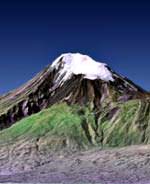
Image credit: NASA
NASA has released detailed topographical data of Europe and Asia that was gathered by the space shuttle as part of the 10-day Shuttle Radar Topography Mission (SRTM) in February 2000 that mapped 80% of the Earth’s surface. This data represents 40-percent of the data collected during the mission. North and South American data has already been made available, and the remainder should be completed by 2004. This precise 3-D mapping information is being used in many applications, including studying natural disasters, planning development, and aircraft navigation.
Marco Polo. Alexander the Great. They were some of history’s most prolific explorers, each trekking across sweeping stretches of Europe and Asia in their lifetimes. But these greats of world history had nothing on you, thanks to a new topographic data set from NASA and the National Geospatial-Intelligence Agency (NGA). You now can explore the vast reaches of most of Europe, Asia and numerous islands in the Indian and Pacific Oceans, from the comfort of home, without breaking a sweat.
Gathered in just 10 days by NASA’s Shuttle Radar Topography Mission (SRTM) in February 2000, the new digital elevation data set showcases some of Earth’s most diverse, mysterious and extreme topography. Much of it previously had been very poorly mapped due to persistent cloud cover or inaccessible terrain. The new data being released comprise more than one-third of the entire SRTM data set.
The new images are available on the JPL Planetary Photojournal at:
http://photojournal.jpl.nasa.gov/catalog/PIA03398
http://photojournal.jpl.nasa.gov/catalog/PIA03399
http://photojournal.jpl.nasa.gov/catalog/PIA04950
http://photojournal.jpl.nasa.gov/catalog/PIA04951
“People around the world will benefit from the release of the SRTM Europe and Asia topographic data sets because they greatly extend our knowledge of this immense region that also is home to most of Earth’s citizens,” said Dr. John LaBrecque, manager, Solid Earth and Natural Hazards Program, NASA Headquarters, Washington.
“The shape of Earth’s surface affects nearly every natural process and human endeavor. Precise, uniform, 3-D elevation data are needed for a wide range of applications from studying earthquakes, volcanism, floods and other natural hazards, to planning development, managing precious water resources, and insuring the safety of aircraft navigation,” LaBrecque noted.
“Releasing the Eurasia SRTM data provides geospatial data users with a remarkably consistent Earth-elevation surface. This enhances our global knowledge, provides a baseline for any future comparisons, and delivers accuracy and integrity unparalleled in any other global-elevation model of the Earth,” said NGA’s Technical Executive Roberta Lenczowski. “This SRTM data represents 40 percent of the data collected during the mission that covered roughly 80 percent of the landmass of the Earth. The cooperative effort between NASA and NGA, fusing science objectives with national security requirements, benefits all,” Lenczowski added.
The area covered in the current data-release stretches eastward from the British Isles and the Iberian Peninsula in the west, across the Alps and Carpathian Mountains, as well as the Northern European Plain, to the Ural and Caucasus Mountains bordering Asia. The Asian coverage includes a great variety of landforms, including the Tibetan Plateau, Tarim Basin, Mongolian Plateau and the mountains surrounding Lake Baikal, the world’s deepest lake. Mt. Everest in the Himalayas, at 8,848 meters (29,029 feet) is the world’s highest mountain. From India’s Deccan Plateau, to Southeast Asia, coastal China, and Korea, various landforms place constraints on land-use planning during periods of population growth. Volcanoes in the East Indies, the Philippines, Japan and the Kamchatka Peninsula form the western part of the “Ring of Fire” around the Pacific Ocean.
Previous releases from the mission covered North and South America. Forthcoming releases in 2004 will include Africa-Arabia and Australia, as well as an “islands” release for those islands not included in the continental data-releases. Together, these data-releases constitute the world’s first high-resolution, near-global elevation model. The resolution of these data for Europe and Asia is three arc seconds (1/1,200 of a degree of latitude and longitude), which is about 90 meters (295 feet).
The SRTM mission is a cooperative project of NASA, NGA and the German and Italian space agencies. NASA’s Jet Propulsion Laboratory, Pasadena, Calif., processed the data into research-quality digital elevation data. The National Geospatial-Intelligence Agency is providing additional processing to develop mapping products. The U.S. Geological Survey Earth Resources Observation Systems Data Center in Sioux Falls, S.D., provides final archiving and distribution of the SRTM data products.
Information about SRTM is available at:
More information about NASA is at:
Original Source: NASA News Release
